I-STEM Program Gives Local High Schoolers Research Experience at Illinois
July 11, 2013
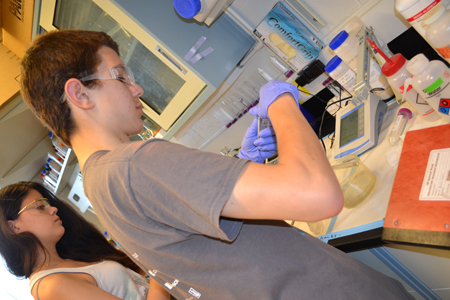
Two local high school students test water samples in Dr. Helen Nguyen's lab.
Instead of tanning in the sun and playing video games all day, a group of high school students chose to devote part of their summer vacation to research in Illinois labs.
This summer 24 students from University Laboratory High School participated in the third annual I-STEM High School Research Experience. While some grappled with coming up with a cure for cancer, others dug through dirt from archeological sites looking for samples. Each student spent four weeks being mentored by an Illinois researcher and doing tasks like making samples in labs, collecting data, and programming software.
In his third year to be involved with ISTEM, University High math teacher Warren Buck feels the I-STEM summer program is getting better with time. "We've figured out what works, and we're still doing it…I think we've figured out a model that works," said Buck.
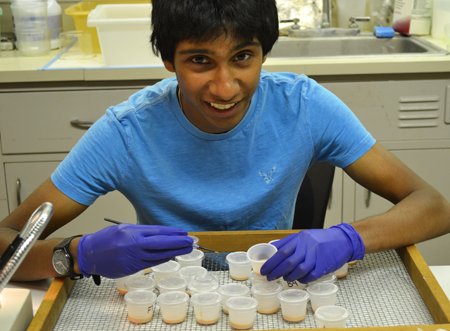
Vikram Bagchi performing research on the navel orangeworm in the Berenbaum lab.
As a kid, Vikram Bagchi, one student in the I-STEM program, would visit his parent's biology labs and always felt an interest in the sciences. This summer was his first time involved with I-STEM, and he immediately felt connected to the research being conducted at the Berenbaum Lab. "So first day, Dr. Berenbaum said she has a project for me. It's on an insect that not many people in the country work on. So I did some research and found that there's nothing on it, really. So I felt like what I'll be doing is some new stuff, and the two grad students I'm working with are really helpful. Overall, I had a really good experience."
Bagchi studied how the navel orangeworm is a pest to cash crops like almonds, pistachios, and figs. In the lab, Bagchi prepared food samples containing a high dosage of Bergapten, a natural pesticide, to see the effects on the navel orangeworm.
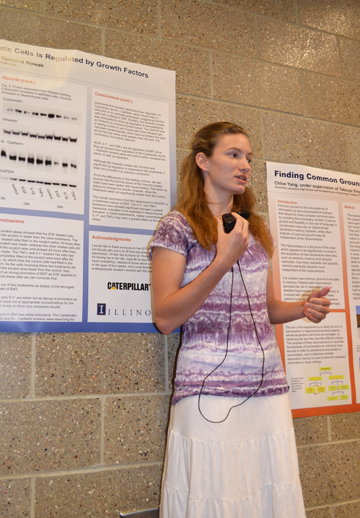
Lea Slauch making her poster presentation on Endometriosis.
This year was Lea Slauch's second year with ISTEM; even though she wants to head to law school. she values the broad base of knowledge she has gained from her experience with STEM-related research. Slauch researched the disease Endometriosis in Dr. Novak's lab. In this gynecological condition faced by women, cells from the uterine lining grow in the lining of the pelvic cavity causing pain and a possible chance of cancer.
"So we're trying to look at this thing called EMT, which is epithelial-mesenchymal transition which is how these epithelial cells can become mobile and make their way into the cavity," said Slauch.
Since 90% of the human body is made up of water, the quality of water we drink becomes very important. Working under Dr. Helen Nguyen, Nathan Beauchamp, Noah Lopez, Ashley Marfarquhar, Diego Gunderson, and Grant Deatley worked on developing an iron-amended biosand filter. Most sand filters remove bacteria and organic matter, but this improved filter successfully removes viruses from water. The students spent their time in the Newmark Laboratory of Civil and Environmental Engineering researching and understanding filters in a very hands-on and practical manner. The students plated samples and ran tests on different sand filters to discover what exactly goes on inside filters at various points.
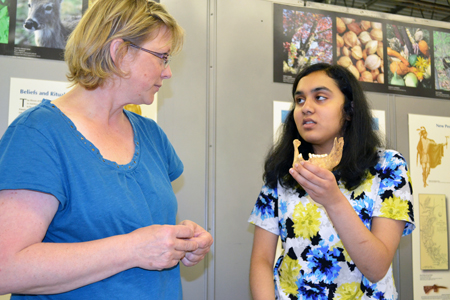
Researcher Christine Hedman and I-STEM high school researcher Nafisa Syed examine the teeth of a sample retrieved from an archaelogical excavation site.
Working with archaeologist Christine Hedman, Nafisa Syed worked to collect and excavate archeological dig-site samples that led to finding a middle-age human's vertebra and ulna. Syed was surprised to learn that a majority of excavating is not done at a dig site, but actually done in labs, where chunks of dirt are brought in and analyzed with the help of a cataloguing system. Syed felt really engaged with the research she was assigned, as it fused together her Science Olympiad work with rocks and minerals and her interest in biology. When asked if she would like to work with ISTEM again, she responded,"It's definitely a nice experience, and I would like to do it next year if I got the chance."
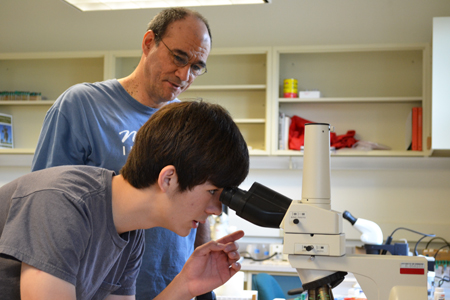
Dr. Felipe Soto-Adames (top left) supervises Josh Meling (bottom left) as he examines springtails through a microscope.
A few students had the opportunity to continue working in their labs over the rest of the summer, such as rising junior Josh Meling. Assisting Dr. Felipe Soto-Adames, Meling analyzed the occurrence of springtails (minute insects without wings) in Brownfield Woods. The team compared their own data to that of an Illinois student who conducted similar research in the 1960s. "There's a lot of information, so the more collecting I do, the more information I can gather and learn; so even after the presentation this Friday, I'll probably go back into the woods," said Meling.
After the four-week journey, all 24 students assembled for their poster presentation at the Digital Computer Lab. The students shared their research in a professional manner and reminded the audience of how important and interesting research is at Illinois.
Author: Sneha Shukla, I-STEM Journalism Intern
Photographs: Sneha Shukla and Elizabeth Innes, I-STEM Webmaster
More: 8-12 Outreach, High School Research, I-STEM Initiatives, Summer Research, Uni High, 2013

I-STEM high school researcher Donna Xia (right) holds a hexabot modeled after the Madagascar Hissing Cockroach Researcher Marianne Alleyne is holding.













.jpg)
















